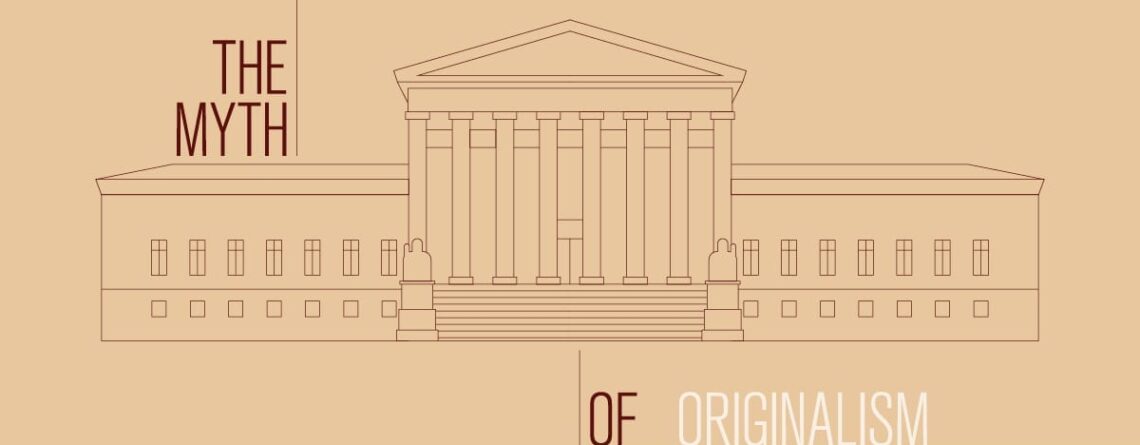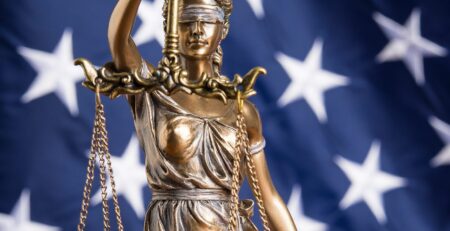“The Constitution that I interpret and apply is not living but dead, or as I prefer to call it, enduring,” said the late Supreme Court Justice Antonin Scalia. “It means today not what current society, much less the court, thinks it ought to mean, but what it meant when it was adopted.”
Scalia was perhaps the most vocal champion of originalism, a group of theories that suggests judges are bound to the original meaning of the U.S. Constitution as it was ratified in 1789 (or 1868, after the adoption of the 14th amendment granting citizenship and civil rights protection to all Americans — including former slaves). Though Scalia died in 2016, his originalist convictions are shared by the justice who filled his seat, Neil Gorsuch. (President Donald Trump’s second Supreme Court nominee, Brett Kavanaugh, also identifies as an originalist.) Originalist judges portray themselves as the opposite of “judicial activists,” judges who rule based on their personal belief system rather than the law.
The problem, according to Eric Segall, the Kathy and Lawrence Ashe Professor of Law at Georgia State, is that many self-proclaimed originalists — including Supreme Court justices — are themselves living constitutionalists (1) using the label “originalist” to achieve politically desirable results.
(1) Living constitutionalism is the understanding that the Constitution may be interpreted in different ways by different generations.
Segall has published a career’s worth of material on the U.S. Supreme Court, and his latest book, “Originalism as Faith,” offers a comprehensive history and analysis of the originalism debates. In addition to a previous book, “Supreme Myths: Why the Supreme Court Is Not a Court and Its Justices Are Not Judges,” Segall’s research and opinions on originalism have appeared in the Harvard and Cornell law reviews, as well as the New York Times and other media outlets.
Here, he discusses the basis of his book and why he thinks it’s a matter of faith that an originalist judge, or any judge for that matter, will apply the law based on the Constitution’s original meaning.
How did originalism become such a dominant judicial theory?
The movement can be traced back to the 1970s, when Judge [Robert] Bork (2) took the position that the Supreme Court should not strike down state or federal laws unless either constitutional text or the Constitution’s original meaning required it. He also advocated for strong deference to political decisions made outside the courts. But few people who claim to be originalists subscribe to that theory today.
How has it changed since?
A big change occurred in the 1990s after conservative judges appointed by Presidents Ronald Reagan and the first George Bush flooded the judiciary. They liked the label of originalism, and they needed a method to justify conservative decisions in cases involving federalism, gun rights and freedom of speech rights, among others. But most of these cases could not be justified under the old deferential originalist approach. Today originalism is a label used by scholars and judges to justify conservative or libertarian ideals.
(2) Robert Heron Bork was solicitor general in the U.S. Department of Justice from 1972 to 1977 and was well known for his belief in originalism theories. He was nominated by President Reagan to the Supreme Court in 1987, but his nomination was controversially defeated by the Senate with a 52-48 vote. He famously said, “The truth is that the judge who looks outside the Constitution always looks inside himself and nowhere else.”
Is the current portrayal of originalism strictly partisan, then?
Another section of the book is devoted to describing and demonstrating that all Supreme Court Justices, whether left, left-center, center, right-center or right, decide cases the same way — based on their values. If the original meaning of the Constitution supports their arguments, conservative or not, they will use that interpretation.
However, if justices care enough about a case, they won’t retreat from a result they want just because the original meaning of the text doesn’t support it. In this sense, there is no real difference between [Supreme Court Justice Ruth Bader] Ginsburg and Scalia (3).
(3) Ruth Bader Ginsburg is known for applying living constitutionalism to her decisions while Antonin Scalia was considered a staunch originalist (though Segall argues he did not vote that way).
Is there an example of a justice taking an opposing view to originalism?
In the 1990s, term limits became a huge political issue in this country, and the state of Arkansas tried to put term limits on members of Congress. Eventually, the issue went to the Supreme Court in U.S. Term Limits, Inc. v. Thornton (4). Justice [Anthony] Kennedy sided with the liberals in this case, which struck down term limits, 5-4. Now, Kennedy did cite some historical sources, but even on this important issue, he mostly relied on his value judgment that the Congress needed a uniform national identity separate from the states. He said that if each state could have different qualifications for members of Congress, it would disrupt that national identity. I’m not defending that. He may be right, or he may be wrong, but he didn’t pretend to base his decision on the opinions of people living 200 years ago.
(4) In U.S. Term Limits, Inc. v. Thornton, the Supreme Court invalidated a state constitutional amendment passed by Arkansas voters in November 1992. The amendment, called “Term Limitation Act,” effectively limited executive officers and state senators to two four-year terms and state representatives to three two-year terms.
Didn’t the Court use originalism in the 2008 Second Amendment case, District of Columbia v. Heller (5)?
Both Justice Scalia’s majority opinion and Justice [John Paul] Stevens’ dissenting opinion spent many pages canvassing the history of the Second Amendment. Historians, however, have not been kind to either justice’s efforts. It is not a coincidence that the five conservatives found that the Second Amendment protected a private right to own guns while the four liberals did not — even though all nine of them reviewed much of the same history.
So we can’t depend on the Supreme Court to go by the book?
There is no such thing as going by the book. How do you go by the book when interpreting due process, equal protection, establishment of religion or cruel and unusual punishment? There is no book for that. These are matters of values all the way down.
(5) In 2008, provisions of a District of Columbia law criminalized the carrying of an unregistered firearm and prohibited the registration of handguns. The law also stipulated that lawfully owned guns must be kept in homes, disassembled and unloaded. The law was struck down 5-4 in the Supreme Court case District of Columbia v. Heller. Justice Scalia wrote the majority opinion, and the case is widely seen as an example of originalism in practice because the Court held that the Second Amendment is an individual right intimately tied to the natural right of self-defense.
What do you hope readers take away from the book?
I hope people understand that the theories preached by Bork and other early originalists never took hold. There’s an idea in this country that Supreme Court justices may only invalidate state and federal laws if they do so based on text or history, but we know that most of the time text and history do not justify their decisions.
We know the values of 1787, when we had slaves and women had no rights, or the values of 1868, when we had segregation and women couldn’t even vote, do not decide cases today. If our values can be symbolically linked to old values, I’m all in favor of that. But old values don’t help us decide whether cell phones are subject to searches based on modern technology or whether presidents can execute American citizens suspected of being terrorists when no judge has adjudicated that claim.
Affirmative action, for example, cannot be viewed through 1868 values because the whole idea of equality for African-Americans, even after the 14th amendment, has changed dramatically. Let’s not pretend we’re deciding cases based on the ideals of a societies that supported segregation, slavery and the oppression of women.
If a law is patently unconstitutional, then it is within a judge’s authority to strike it down. On issues reasonable people can disagree about, like the constitutionality of abortion, gun control, affirmative action and campaign finance laws, we should be allowed to vote.
“There’s an idea in this country that Supreme Court justices may only invalidate state and federal laws if they do so based on text or history, but we know that most of the time text and history do not justify their decisions.”
A DOCTRINE’S ABIDING ALLURE
An excerpt from Segall’s book “Originalism as Faith”
Why do some Supreme Court justices and lower court judges so often talk about the importance of originalism in their decisions but consistently vote for non-originalist outcomes? The answer may be that for many legal actors (law students, lawyers, judges, law professors), and for the public, it is a matter of faith that only something called “originalism” can constrain judges.
In one recent survey, 70 percent of the people polled thought the Supreme Court is a political body “too mixed up in politics.” On one level, the American people are not naïve when it comes to wrestling with the confluence of law and politics in the Court’s decisions. There is nonetheless great resistance among the people to fully embrace that perspective of the justices. The Court’s popularity has dipped in recent years, but it still is far more popular than Congress or the president.
To accept the realist critique would, in the eyes of many observers, undercut the rationale for allowing judges to strike down acts of more accountable governmental officials. Although many legal realists disagree that their critique fatally undercuts the rationale for judicial review, legal academics and most originalists need to be able to justify the Court’s decision-making on the basis that preexisting text, or other positive law materials, drive the justices’ opinions. As [Columbia Law School professor] Jamal Greene has put it, “the selling of originalism” is to a large degree centered around the idea that only strong fidelity to text and original meaning can support unelected judges possessing so much power in our constitutional, representative democracy. But this idea glosses over major disconnects between the rhetoric of originalism and real-life constitutional interpretation by judges deciding actual cases.
Since the 1980s, the label “originalism” has been an effective political tool employed by some (certainly not all) conservatives and libertarians to justify the appointment of judges whose politics and values they prefer. The claim that originalist judges “apply, not make the law,” appeals to the public’s wish to believe the justices are above normal politics (even if at some level the public knows that isn’t true).
© 2018 by Eric Segall. Used with permission from Cambridge University Press.
“The Constitution that I interpret and apply is not living but dead, or as I prefer to call it, enduring,” said the late Supreme Court Justice Antonin Scalia. “It means today not what current society, much less the court, thinks it ought to mean, but what it meant when it was adopted.”
Scalia was perhaps the most vocal champion of originalism, a group of theories that suggests judges are bound to the original meaning of the U.S. Constitution as it was ratified in 1789 (or 1868, after the adoption of the 14th amendment granting citizenship and civil rights protection to all Americans — including former slaves). Though Scalia died in 2016, his originalist convictions are shared by the justice who filled his seat, Neil Gorsuch. (President Donald Trump’s second Supreme Court nominee, Brett Kavanaugh, also identifies as an originalist.) Originalist judges portray themselves as the opposite of “judicial activists,” judges who rule based on their personal belief system rather than the law.
The problem, according to Eric Segall, the Kathy and Lawrence Ashe Professor of Law at Georgia State, is that many self-proclaimed originalists — including Supreme Court justices — are themselves living constitutionalists (1) using the label “originalist” to achieve politically desirable results.
(1) Living constitutionalism is the understanding that the Constitution may be interpreted in different ways by different generations.
Segall has published a career’s worth of material on the U.S. Supreme Court, and his latest book, “Originalism as Faith,” offers a comprehensive history and analysis of the originalism debates. In addition to a previous book, “Supreme Myths: Why the Supreme Court Is Not a Court and Its Justices Are Not Judges,” Segall’s research and opinions on originalism have appeared in the Harvard and Cornell law reviews, as well as the New York Times and other media outlets.
Here, he discusses the basis of his book and why he thinks it’s a matter of faith that an originalist judge, or any judge for that matter, will apply the law based on the Constitution’s original meaning.
How did originalism become such a dominant judicial theory?
The movement can be traced back to the 1970s, when Judge [Robert] Bork (2) took the position that the Supreme Court should not strike down state or federal laws unless either constitutional text or the Constitution’s original meaning required it. He also advocated for strong deference to political decisions made outside the courts. But few people who claim to be originalists subscribe to that theory today.
(2) Robert Heron Bork was solicitor general in the U.S. Department of Justice from 1972 to 1977 and was well known for his belief in originalism theories. He was nominated by President Reagan to the Supreme Court in 1987, but his nomination was controversially defeated by the Senate with a 52-48 vote. He famously said, “The truth is that the judge who looks outside the Constitution always looks inside himself and nowhere else.”
How has it changed since?
A big change occurred in the 1990s after conservative judges appointed by Presidents Ronald Reagan and the first George Bush flooded the judiciary. They liked the label of originalism, and they needed a method to justify conservative decisions in cases involving federalism, gun rights and freedom of speech rights, among others. But most of these cases could not be justified under the old deferential originalist approach. Today originalism is a label used by scholars and judges to justify conservative or libertarian ideals.
Is the current portrayal of originalism strictly partisan, then?
Another section of the book is devoted to describing and demonstrating that all Supreme Court Justices, whether left, left-center, center, right-center or right, decide cases the same way — based on their values. If the original meaning of the Constitution supports their arguments, conservative or not, they will use that interpretation.
However, if justices care enough about a case, they won’t retreat from a result they want just because the original meaning of the text doesn’t support it. In this sense, there is no real difference between [Supreme Court Justice Ruth Bader] Ginsburg and Scalia (3).
(3) Ruth Bader Ginsburg is known for applying living constitutionalism to her decisions while Antonin Scalia was considered a staunch originalist (though Segall argues he did not vote that way).
Is there an example of a justice taking an opposing view to originalism?
In the 1990s, term limits became a huge political issue in this country, and the state of Arkansas tried to put term limits on members of Congress. Eventually, the issue went to the Supreme Court in U.S. Term Limits, Inc. v. Thornton (4). Justice [Anthony] Kennedy sided with the liberals in this case, which struck down term limits, 5-4. Now, Kennedy did cite some historical sources, but even on this important issue, he mostly relied on his value judgment that the Congress needed a uniform national identity separate from the states. He said that if each state could have different qualifications for members of Congress, it would disrupt that national identity. I’m not defending that. He may be right, or he may be wrong, but he didn’t pretend to base his decision on the opinions of people living 200 years ago.
(4) In U.S. Term Limits, Inc. v. Thornton, the Supreme Court invalidated a state constitutional amendment passed by Arkansas voters in November 1992. The amendment, called “Term Limitation Act,” effectively limited executive officers and state senators to two four-year terms and state representatives to three two-year terms.
Didn’t the Court use originalism in the 2008 Second Amendment case, District of Columbia v. Heller (5)?
Both Justice Scalia’s majority opinion and Justice [John Paul] Stevens’ dissenting opinion spent many pages canvassing the history of the Second Amendment. Historians, however, have not been kind to either justice’s efforts. It is not a coincidence that the five conservatives found that the Second Amendment protected a private right to own guns while the four liberals did not — even though all nine of them reviewed much of the same history.
(5) In 2008, provisions of a District of Columbia law criminalized the carrying of an unregistered firearm and prohibited the registration of handguns. The law also stipulated that lawfully owned guns must be kept in homes, disassembled and unloaded. The law was struck down 5-4 in the Supreme Court case District of Columbia v. Heller. Justice Scalia wrote the majority opinion, and the case is widely seen as an example of originalism in practice because the Court held that the Second Amendment is an individual right intimately tied to the natural right of self-defense.
So we can’t depend on the Supreme Court to go by the book?
There is no such thing as going by the book. How do you go by the book when interpreting due process, equal protection, establishment of religion or cruel and unusual punishment? There is no book for that. These are matters of values all the way down.
“There’s an idea in this country that Supreme Court justices may only invalidate state and federal laws if they do so based on text or history, but we know that most of the time text and history do not justify their decisions.”
What do you hope readers take away from the book?
I hope people understand that the theories preached by Bork and other early originalists never took hold. There’s an idea in this country that Supreme Court justices may only invalidate state and federal laws if they do so based on text or history, but we know that most of the time text and history do not justify their decisions.
We know the values of 1787, when we had slaves and women had no rights, or the values of 1868, when we had segregation and women couldn’t even vote, do not decide cases today. If our values can be symbolically linked to old values, I’m all in favor of that. But old values don’t help us decide whether cell phones are subject to searches based on modern technology or whether presidents can execute American citizens suspected of being terrorists when no judge has adjudicated that claim.
Affirmative action, for example, cannot be viewed through 1868 values because the whole idea of equality for African-Americans, even after the 14th amendment, has changed dramatically. Let’s not pretend we’re deciding cases based on the ideals of a societies that supported segregation, slavery and the oppression of women.
If a law is patently unconstitutional, then it is within a judge’s authority to strike it down. On issues reasonable people can disagree about, like the constitutionality of abortion, gun control, affirmative action and campaign finance laws, we should be allowed to vote.
A DOCTRINE’S ABIDING ALLURE
An excerpt from Segall’s book “Originalism as Faith”
Why do some Supreme Court justices and lower court judges so often talk about the importance of originalism in their decisions but consistently vote for non-originalist outcomes? The answer may be that for many legal actors (law students, lawyers, judges, law professors), and for the public, it is a matter of faith that only something called “originalism” can constrain judges.
In one recent survey, 70 percent of the people polled thought the Supreme Court is a political body “too mixed up in politics.” On one level, the American people are not naïve when it comes to wrestling with the confluence of law and politics in the Court’s decisions. There is nonetheless great resistance among the people to fully embrace that perspective of the justices. The Court’s popularity has dipped in recent years, but it still is far more popular than Congress or the president.
To accept the realist critique would, in the eyes of many observers, undercut the rationale for allowing judges to strike down acts of more accountable governmental officials. Although many legal realists disagree that their critique fatally undercuts the rationale for judicial review, legal academics and most originalists need to be able to justify the Court’s decision-making on the basis that preexisting text, or other positive law materials, drive the justices’ opinions. As [Columbia Law School professor] Jamal Greene has put it, “the selling of originalism” is to a large degree centered around the idea that only strong fidelity to text and original meaning can support unelected judges possessing so much power in our constitutional, representative democracy. But this idea glosses over major disconnects between the rhetoric of originalism and real-life constitutional interpretation by judges deciding actual cases.
Since the 1980s, the label “originalism” has been an effective political tool employed by some (certainly not all) conservatives and libertarians to justify the appointment of judges whose politics and values they prefer. The claim that originalist judges “apply, not make the law,” appeals to the public’s wish to believe the justices are above normal politics (even if at some level the public knows that isn’t true).
© 2018 by Eric Segall. Used with permission from Cambridge University Press.
Photo by Meg Buscema












Leave a Reply